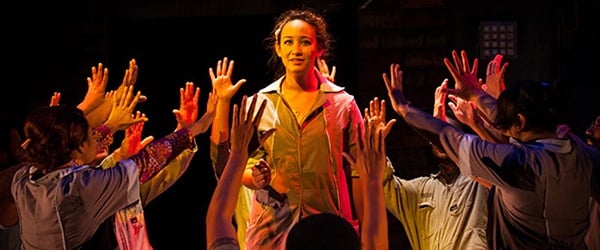Home | Blog | The Factory & Mud Map
The Factory & Mud Map
Image by Andrew Malmo
This last fortnight I saw two live performances. The Factory, at Parramatta Riverside Theatres, within a well-trodden format about hardship faced when navigating a new life in another country, is a musical about migration from Samoa to ‘the big smoke’ that is Auckland, New Zealand. The other, NAISDA’s mid year show Mud Map, is an exploratory showcase about self awareness in a new environment, where traditional theatrical structures were only limited to the current developing artist student body’s imagination.
Both featured cultural specificity.
Watching both I realised that it’s not the big sweeping steps that speak of specificity, nor the high legs or high notes.
Instead it can be found in the way an eyebrow is raised, double bounce in the knees and ankles before springing like a cat, the rolling of wrists gently enticing the viewer to come hither, or the touching of another body part in response to a superstition or acknowledgement of something unseen, the way one gestures to another in greeting, or bodies grouping according to mysterious custom.
I noticed a while ago that the majority of my NAISDA-trained alumni perform contemporary dance with their mouths closed, as opposed to the ever-so-slightly parted lips of their mainstream peers. When they are dancing hard and have their ‘groove on’ lips are pressed flat, in determination.
There is what I call the Mokuy stare, an affectation or gesture developed from Yolngu (North East Arnhem Land) dance training, whereby the head is tilted forward, the eyes making direct unwavering connection with the audience, or the objective of their imagination, as opposed to the lengthened neck, uplifted chin, with gaze, while not entirely vacant, not usually directed with a pinpoint precision in declaration of contact.
Details like the flat-footed step in stealth, not to-heel gliding of the classically trained ballet dancer, nor the heel-to-toe roll emulating the casual pedestrian.
What is great about the NAISDA mob and the vocabularies that spring forth, is the juxtaposition of western and indigenous movement, not merely within a phrase, but within a second. At one point the leg can be extending slowly, outward and upward in a grand battement, to be brought down in a resounding flat-footed, double-shunted, backward stamping motion. There are endless possibilities as each new generation assimilates the variety of movement styles within their bodies.
This was what also made viewing The Factory so enjoyable, the blending vocal harmonies of cultural singing seamlessly with standard western form, while intermingling the body postures and mannerisms of the Samoan culture with everyday repetitive gestures of working in a factory. It was a mix of The Pyjama Game (factory setting) meets Hairspray (big hair, big dreams) meets the movie Boy (innocence prevailing).
There is a very fine line that a work of cultural significance must negotiate; to hold onto the essence of a people, maintain a difference, while simultaneously inviting others to enjoy, celebrate and understand the importance of keeping a variety of social and theatrical custom going long into the future.
After both performances I came away with more knowledge than going in and happily I laughed (I’m partial to a good comedy). I appreciate the diverse contemporary theatrical landscape where ancient, classical, cutting edge, feel good and done well each have their place alongside one another, as well as any combination of the above.
– by Vicki Van Hout

